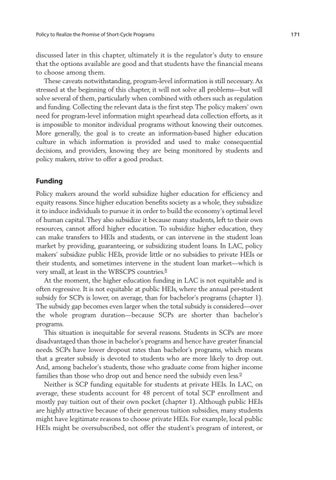Policy to Realize the Promise of Short-Cycle Programs
discussed later in this chapter, ultimately it is the regulator’s duty to ensure that the options available are good and that students have the financial means to choose among them. These caveats notwithstanding, program-level information is still necessary. As stressed at the beginning of this chapter, it will not solve all problems—but will solve several of them, particularly when combined with others such as regulation and funding. Collecting the relevant data is the first step. The policy makers’ own need for program-level information might spearhead data collection efforts, as it is impossible to monitor individual programs without knowing their outcomes. More generally, the goal is to create an information-based higher education culture in which information is provided and used to make consequential decisions, and providers, knowing they are being monitored by students and policy makers, strive to offer a good product.
Funding Policy makers around the world subsidize higher education for efficiency and equity reasons. Since higher education benefits society as a whole, they subsidize it to induce individuals to pursue it in order to build the economy’s optimal level of human capital. They also subsidize it because many students, left to their own resources, cannot afford higher education. To subsidize higher education, they can make transfers to HEIs and students, or can intervene in the student loan market by providing, guaranteeing, or subsidizing student loans. In LAC, policy makers’ subsidize public HEIs, provide little or no subsidies to private HEIs or their students, and sometimes intervene in the student loan market—which is very small, at least in the WBSCPS countries.8 At the moment, the higher education funding in LAC is not equitable and is often regressive. It is not equitable at public HEIs, where the annual per-student subsidy for SCPs is lower, on average, than for bachelor’s programs (chapter 1). The subsidy gap becomes even larger when the total subsidy is considered—over the whole program duration—because SCPs are shorter than bachelor’s programs. This situation is inequitable for several reasons. Students in SCPs are more disadvantaged than those in bachelor’s programs and hence have greater financial needs. SCPs have lower dropout rates than bachelor’s programs, which means that a greater subsidy is devoted to students who are more likely to drop out. And, among bachelor’s students, those who graduate come from higher income families than those who drop out and hence need the subsidy even less.9 Neither is SCP funding equitable for students at private HEIs. In LAC, on average, these students account for 48 percent of total SCP enrollment and mostly pay tuition out of their own pocket (chapter 1). Although public HEIs are highly attractive because of their generous tuition subsidies, many students might have legitimate reasons to choose private HEIs. For example, local public HEIs might be oversubscribed, not offer the student’s program of interest, or
171

